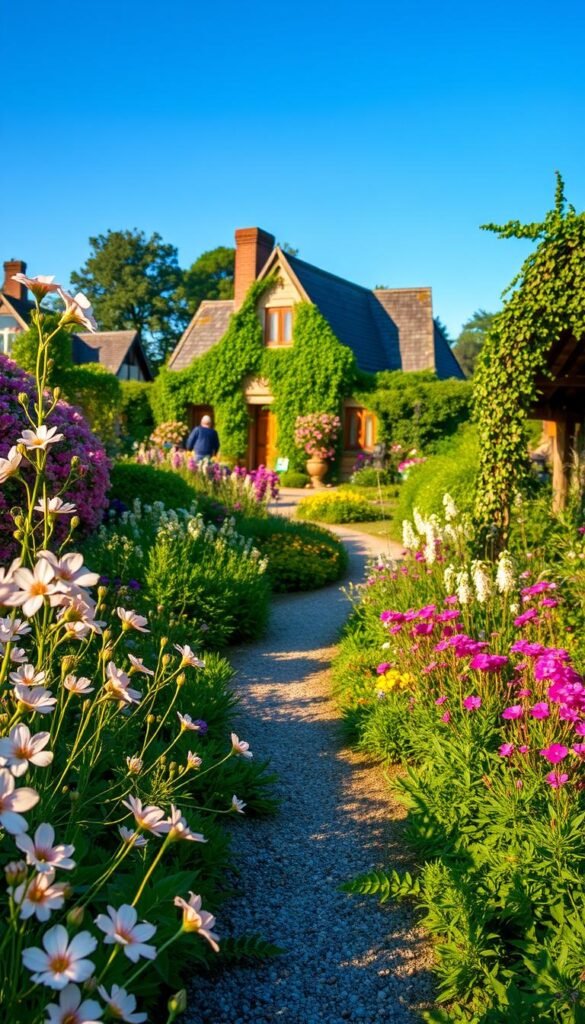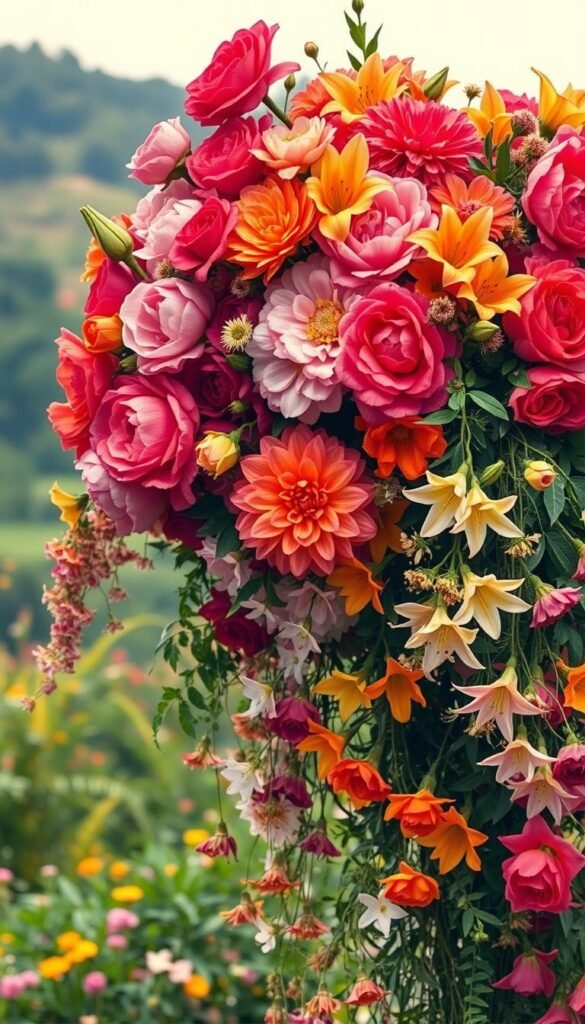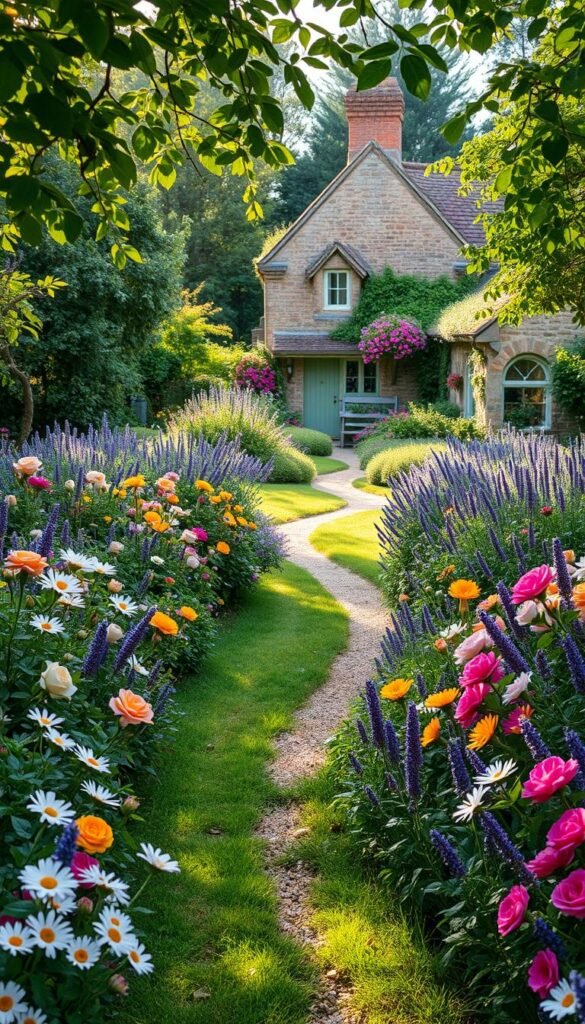Picture a landscape where vibrant flowers mingle with fragrant herbs, framed by walkways that beckon you forward. This style began centuries ago as practical plots for growing food, blending fruit trees with medicinal plants. Over time, it evolved into an art form celebrating nature’s spontaneity.
Today’s versions balance organization with playful freedom. Structured layouts meet unexpected bursts of color, while pathways guide visitors through ever-changing views. These designs feel both curated and effortlessly wild—a quality that makes them endlessly captivating.
You’ll find these spaces excel at supporting local ecosystems. Butterflies flock to nectar-rich blossoms, while birds nestle among dense foliage. Every season brings new textures and hues, from spring’s delicate petals to autumn’s golden grasses.
This guide reveals how to craft your own sanctuary using time-tested principles. Discover planting strategies that ensure year-round interest and learn to arrange elements for maximum visual impact. Whether you have acres or a modest yard, these techniques help transform ordinary areas into living artworks.
Embracing the Cottage Garden Aesthetic

What began as humble vegetable patches transformed into living tapestries of color. This design philosophy celebrates nature’s quirks rather than taming them—think foxgloves leaning over stone edges and herbs sprouting between paving cracks.
Understanding the Allure of Informal Charm
You’ll find magic in the “organized clutter” approach. Plants tumble over each other like old friends, creating layers of texture that shift with the breeze. It’s not about perfection—it’s about letting columbines self-seed where they please and allowing roses to climb fence posts unchecked.
“A true cottage-style space feels like it’s been loved for decades, even if you planted it last spring.”
History and Evolution
Originally, these spaces maximized food production in tiny areas. Families grew apples alongside cabbages, with marigolds planted to deter pests. By the 19th century, the style gained romantic appeal as floral varieties joined the mix.
Today’s versions blend that practicality with creative freedom. You might pair heirloom tomatoes with lavender, or let nasturtiums spill across stepping stones. The key? Balancing structure (like defined pathways) with joyful plant partnerships that surprise and delight.
The Origins and Evolution of Cottage Garden Style

Long before becoming a design trend, these plant-filled spaces emerged from basic human needs. Early versions served as survival plots where families grew apples, beans, and medicinal herbs in tight quarters. Every leaf and stem had purpose—food came first, beauty second.
From Utilitarian Beginnings to Artistic Expression
You’d find marigolds nestled between cabbages not for decoration, but to repel pests. Over time, practicality blended with creativity as flowers like hollyhocks joined the mix. What began as life-sustaining patches became canvases for self-expression.
Today’s designs honor that legacy. Your modern space might pair lavender with strawberries or let nasturtiums cascade over walkways. This approach keeps the original spirit alive—productive yet playful.
Early gardeners mastered companion planting out of necessity. They discovered which plants thrived together, creating partnerships we still use. By blending edible and ornamental varieties, you continue this tradition while embracing the cottagecore aesthetic.
The shift from survival to artistry means your garden can prioritize beauty without losing function. Dill attracts swallowtails while seasoning pickles. Sunflowers feed birds and frame photos. Every choice connects past and present.
Planning Your Garden Layout: Paths, Beds, and Borders

Designing a thriving plant sanctuary starts with smart spatial organization. Layers of foliage and blossoms can overwhelm your area without intentional pathways and defined edges. Let’s explore how to shape your outdoor zones for beauty and function.
Mapping Your Space for Maximum Impact
Begin by sketching sunlight patterns across your plot. Morning rays might highlight a cluster of peonies, while afternoon shade could host ferns. Strategic placement ensures each species thrives in its ideal conditions.
Create visual journeys using curved walkways. A gentle bend might reveal lavender-lined seating or a cluster of sunflowers. These surprises keep the eye moving and spark curiosity.
| Sun Exposure | Plant Types | Design Tips |
|---|---|---|
| Full Sun | Echinacea, Sage | Position near seating areas |
| Partial Shade | Hostas, Bleeding Hearts | Frame pathways |
| Dappled Light | Hydrangeas, Ferns | Use as natural dividers |
Integrating Natural Elements and Texture
Existing boulders or mature trees become design anchors. Cluster foxgloves around weathered stones, or let ivy climb a gnarled trunk. These features add organic character that new installations can’t replicate.
Mix feathery grasses with broad-leafed hostas along walkway edges. The contrast catches light differently throughout the day, creating living art that evolves with the hours.
The Magic of Winding Stone Paths

Every twist in a meandering path invites curiosity, turning a simple walk into an adventure. These organic walkways do more than connect spaces—they shape how visitors experience your plant-filled sanctuary. Let’s explore how to design routes that balance whimsy with practicality.
Designing Meandering Walkways
Start by sketching gentle curves that follow your land’s natural contours. Flagstones or irregular cobblestones work best for creating uneven edges that blend with wildflower clusters. Space stones slightly apart to allow creeping thyme or moss to soften their lines, adding texture underfoot.
Avoid perfect symmetry. Let pathways narrow unexpectedly near fragrant herbs or widen beside seating areas. This creates rhythm, encouraging visitors to slow down and notice details like sparkling dewdrops on spiderwebs or bees pollinating nearby blooms.
Tips for Practical and Aesthetic Stone Placement
Test foot traffic flow before finalizing layouts. Place larger, flatter stones where people naturally pause—like near birdbaths or statement plantings. Use gravel fill between stones in high-traffic zones to prevent soil erosion while maintaining a rustic look.
Match stone colors to your home’s exterior for cohesion. Warm sandstone complements brick walls, while slate grays echo weathered fences. Bury stones partially to mimic aged pathways naturally settled over time. This technique also prevents tripping hazards during rainy seasons.
Selecting Romantic Blooms and Vibrant Colors

Your plant sanctuary becomes a living painting when hues collide in purposeful harmony. Imagine fiery marigolds dancing with violet salvias, or sunlit daisies contrasting midnight-hued irises. These pairings don’t happen by accident—they’re crafted using nature’s own color rules.
Choosing Flowers That Bloom in Harmony
Start by mixing heights and bloom times. Tall hollyhocks frame shorter cosmos, while early-blooming peonies pass the baton to late-summer phlox. This layering ensures visual interest from spring frost to autumn’s first chill.
Pair feathery astilbe with bold dahlias for texture contrast. Include aromatic herbs like thyme between flowers—their foliage adds greenery and attracts pollinators. For continuous color, follow the companion plant pairings that thrive together in sun or shade.
Utilizing Complementary Color Palettes
The color wheel becomes your secret weapon. Opposite hues create electric energy—think golden rudbeckia against purple coneflowers. Soften intense combinations with neutral whites and creams from Shasta daisies or moonflowers.
Try these showstoppers:
- Sunset tones: Orange poppies + blue delphiniums
- Jewel box: Crimson roses + sage-green lamb’s ear
- Twilight magic: Yellow coreopsis + indigo baptisia
Remember to let nature guide you. A volunteer borage plant might spark your next brilliant combination, proving that planned beauty and happy accidents make perfect partners.
Creating a Harmonious Space for Pollinators
Imagine your outdoor area buzzing with life as winged visitors dance between blossoms. By designing with pollinators in mind, you’ll transform your space into a thriving habitat while maintaining its visual charm.
Attracting Bees with Purple and Lavender Hues
Bees see the world differently—their vision detects ultraviolet light, making purple blooms glow like neon signs. Plant clusters of lavender, salvia, and catmint to create irresistible landing pads. These bee magnets offer abundant nectar while adding depth to your color scheme.
Catmint stands out as a multitasker. Its violet spikes attract pollinators while deterring pests, and it thrives in various soils. Pair it with Russian sage for contrasting textures that sway gracefully in summer breezes.
Planting for Year-Round Buzz and Activity
Keep your space lively through every season with strategic choices. Early-blooming crocuses provide spring snacks, while autumn asters fuel final foraging flights. For continuous support, mix native species like milkweed with container gardening flowers that extend the blooming calendar.
Consider this seasonal lineup:
- Spring: Lupines and alliums
- Summer: Bee balm and phlox
- Fall: Goldenrod and sedum
By layering bloom times and plant heights, you create a living buffet that sustains pollinators while offering ever-changing visual interest. Your efforts help local ecosystems thrive—one flower at a time.
Designing Mixed Borders with Cottage Flowers
Transform your outdoor edges into living tapestries where blossoms jostle playfully for attention. Start by grouping species that thrive together—daisies bring cheerfulness, lavender adds structure, and hollyhocks tower like floral sentinels. This approach builds depth while inviting exploration.
Layering Plants for Texture and Movement
Arrange taller varieties like foxgloves behind mid-height phlox, letting low-growing thyme spill onto walkways. The secret? Vary leaf shapes—pair spiky iris blades with rounded sage foliage. This contrast catches light differently, creating dynamic shadows that dance in the breeze.
Allow self-seeding annuals to mingle freely between perennials. Poppies might pop up between peonies, adding spontaneity. Embrace slight chaos—it’s how nature designs best. For lasting impact, include modern cultivars like disease-resistant roses alongside heirloom favorites.
Smart plant partnerships reduce upkeep. Pair drought-tolerant sedum with moisture-loving astilbe in zones where soil varies. Explore cottage garden ideas that balance wild beauty with practical care. Your borders will flourish season after season, becoming richer with each passing year.
Incorporating Evergreens and Ornamental Grasses
What keeps your outdoor space lively when summer colors fade? Evergreen shrubs and swaying grasses add texture through every season. These elements maintain structure while letting seasonal stars shine.
Using Low-Growing Juniper and Boxwoods as Backdrops
Compact junipers create a year-round foundation for showier plants. Their blue-green needles contrast beautifully with snow or autumn leaves. Try tucking them behind spring bulbs—they’ll hide fading foliage as temperatures rise.
Boxwoods offer crisp shapes amid flowing perennials. Shear them into soft mounds rather than strict forms. This approach maintains the relaxed feel while preventing bare winter spots. Pair with feathery Miscanthus grass for movement that dances in cold winds.
Ornamental grasses bring unexpected winter drama. Leave their seed heads standing—frost transforms them into sparkling sculptures. Come spring, cut them back just as new shoots emerge. This timing protects roots while letting sunlight reach emerging plants.
Your space gains depth and rhythm when combining these elements. The result? A living composition that evolves gracefully, celebrating nature’s cycles through every seasonal shift.






